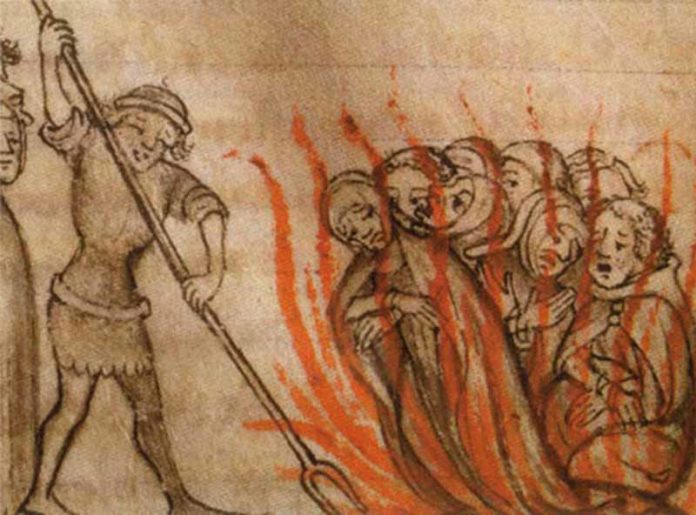The destruction of the Knights Templar came as a result of greed on the part of the French king, Philip IV, and not at the hands of the Catholic Church and it’s pope.
Anyone who has read Dan Brown’s The Da Vinci Code has heard of the Knights Templar. What most people don’t know is the name of the pope who is often incorrectly credited with the Templar’s destruction in the early fourteenth-century. That man was Pope Clement V and regardless of how popular culture—and Dan Brown—portrays Clement, in reality, he had very little to do with the eradication of the most well known crusaders and everything to do with opposing the French king who actually destroyed the organization.
Few popes have been unjustly demonized more by today’s popular culture than Clement V and most people don’t even know who he was. When the Templars were rounded up and arrested Clement had no previous knowledge of the action, but was forced into an awkward situation of compromise.
Unam Sanctam Controversy
Upon Clement’s election as pope in 1305 he began fighting a long and complex political battle with the French king of the time, Philip IV (the Fair). Philip had slowly become the most powerful ruler in Europe. Clement’s predecessors, Pope Boniface VIII, attempted to limit the power of secular rulers by issuing the papal bull Unam Sanctam. The papal bull voiced that there could only be one ultimate power on earth and that that should be the spiritual power of the Catholic Church and all other temporal powers should forever remain subordinate.
This bull openly threatened the power of Philip the Fair and his aim to acquire Church money and land. Rather than relent his hostile position, Philip marched into Italy with his army, kidnapped Boniface VIII, and possibly had him beaten. Boniface died shortly after his confrontation with Philip making the king no friend of the papal throne.
Knights Templar are Arrested
In 1307 Philip the Fair was running low on money and needed access to a large influx of capital to keep his ambitious plans of French expansion moving; the Knights Templar became an easy target. Sixteen years before their arrest the Knights Templar lost their last foothold in the Holy Land with the fall of their stronghold at Acre and therefore lost their relevancy to the world as the Holy Land would never be retaken. During their existence the Templars developed into a wealthy order of knights and lords. They had acquired fiefdoms, church lands, and unimaginable wealth, and the French king wanted it all. On 13 October 1307 Philip put out an order to arrest all Templars on a myriad of charges that included blasphemy, sodomy, and of course, heresy.
The image of hundreds of men being brutally murdered and burned at the stake that very night could not be farther from what happened. Many Templars were arrested, but none were killed that night. Philip might have been the most powerful ruler in Europe, but he still needed the action sanctioned by the Church. This is where Clement was forced to compromise, to a point.
Before Clement was elected pope, Philip the Fair had been pushing for a trial against Pope Boniface VIII in order to have the dead pope excommunicated on the grounds of heresy. Boniface made the mistake of standing up against the French king and paid the price with his freedom. Clement had been slowly putting off a trial against Boniface the day he became pope. With the arrest of the Knights Templar, Philip had in reality given Clement a powerful bargaining chip. Now each man needed something the other could give him. Clement wanted the office of the pope to be cleared of any heresy charges and Philip wanted the Templar wealth.
Knights Templar Executions
For five years the Templar’s fate was held in limbo as Clement pushed back a decision over and over until Philip threatened action against the pope. It was not until 1312 with the conclusion of the Council of Vienne that a decision was finally made. In 1312 it was ruled that the Knights Templar were guilty of heresy and that the order was to be disbanded, but instead of mass burnings at the stake only two men died; the Grand Master of the Templars, Jacques de Molay and one of his associates, Geoffrey of Charney. In exchange, Philip was cleared of all charges of heresy that were laid during the pontificate of Boniface VIII, and Philip relented in his push for heresy charges against Boniface and the office of the pope. However, Philip was denied the wealth he desired.
In one last act of defiance, Clement V did not allow the Templar wealth to flow to Philip and the French coffers. He gave the bulk of the Templar wealth to the second largest knightly order, the Knights Hospitallers. Philip received nothing out of his desperate efforts for money except for five years of headaches and wasted money. Clement, on the other hand, got the office of the pope cleared of all offenses and strengthened another holy order of knights. Not bad for a compromise.
Sources:
- Menache, Sophia. Clement V (London: Cambridge University Press, 1998)
- Mollat, Guillaume. Popes at Avignon, 1305-1378. (London: T. Nelson, 1963)
- Renouard, Yves. Avignon Papacy, 1305-1403; Translated by Denis Bethell (London: Faber, 1965)








